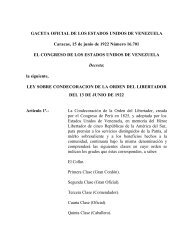Chapter 5 - WebRing
Chapter 5 - WebRing
Chapter 5 - WebRing
Create successful ePaper yourself
Turn your PDF publications into a flip-book with our unique Google optimized e-Paper software.
CHAPTER 5. MAGNETIC SYSTEMS 243<br />
Problem 5.8. What is the maximum value of tanhβJ? Show that for finite values of βJ, G(r)<br />
given by (5.54) decays with increasing r.<br />
∗ General calculation of G(r) in one dimension. To calculate G(r) in the absence of an<br />
external magnetic field we assume free boundary conditions. It is useful to generalize the Ising<br />
model and assume that the magnitude of each of the nearest neighbor interactions is arbitrary so<br />
that the total energy E is given by<br />
N−1 <br />
E = − Jisisi+1, (5.59)<br />
i=1<br />
where Ji is the interaction energy between spin i and spin i+1. At the end of the calculation we<br />
will set Ji = J. We will find in Section 5.5.4 that m = 0 for T > 0 for the one-dimensional Ising<br />
model. Hence, we can write G(r) = sksk+r. For the form (5.59) of the energy, sksk+r is given by<br />
where<br />
sksk+r = 1<br />
<br />
ZN<br />
s1=±1<br />
N−1<br />
ZN = 2<br />
··· <br />
sN=±1<br />
<br />
N−1<br />
sksk+r exp<br />
i=1<br />
βJisisi+1<br />
<br />
, (5.60)<br />
<br />
2coshβJi. (5.61)<br />
i=1<br />
The right-hand side of (5.60) is the value of the product of two spins separated by a distance r in<br />
a particular microstate times the probability of that microstate.<br />
We now use a trick similar to that used in Section 3.5 and the Appendix to calculate various<br />
sums and integrals. If we take the derivative of the exponential in (5.60) with respect to Jk, we<br />
bring down a factor of βsksk+1. Hence, the spin-spin correlation function G(r = 1) = sksk+1 for<br />
the Ising model with Ji = J can be expressed as<br />
sksk+1 = 1<br />
<br />
ZN<br />
s1=±1<br />
= 1 1<br />
ZN β<br />
= 1 1<br />
ZN β<br />
∂<br />
∂Jk<br />
= sinhβJ<br />
coshβJ<br />
··· <br />
sN=±1<br />
<br />
N−1 <br />
sksk+1exp<br />
··· <br />
i=1<br />
N−1 <br />
exp<br />
s1=±1 sN=±1 i=1<br />
<br />
∂ZN(J1,··· ,JN−1) <br />
<br />
∂Jk<br />
<br />
Ji=J<br />
βJisisi+1<br />
βJisisi+1<br />
<br />
<br />
(5.62a)<br />
(5.62b)<br />
(5.62c)<br />
= tanhβJ, (5.62d)<br />
where we have used the form (5.61) for ZN. To obtain G(r = 2), we use the fact that s2 k+1<br />
write sksk+2 = sk(sk+1sk+1)sk+2 = (sksk+1)(sk+1sk+2). We write<br />
G(r = 2) = 1<br />
<br />
<br />
N−1<br />
sksk+1sk+1sk+2 exp βJisisi+1<br />
ZN<br />
{sj}<br />
i=1<br />
= 1<br />
ZN<br />
<br />
= 1 to<br />
(5.63a)<br />
1<br />
β2 ∂2ZN(J1,··· ,JN−1)<br />
= [tanhβJ]<br />
∂Jk∂Jk+1<br />
2 . (5.63b)

















